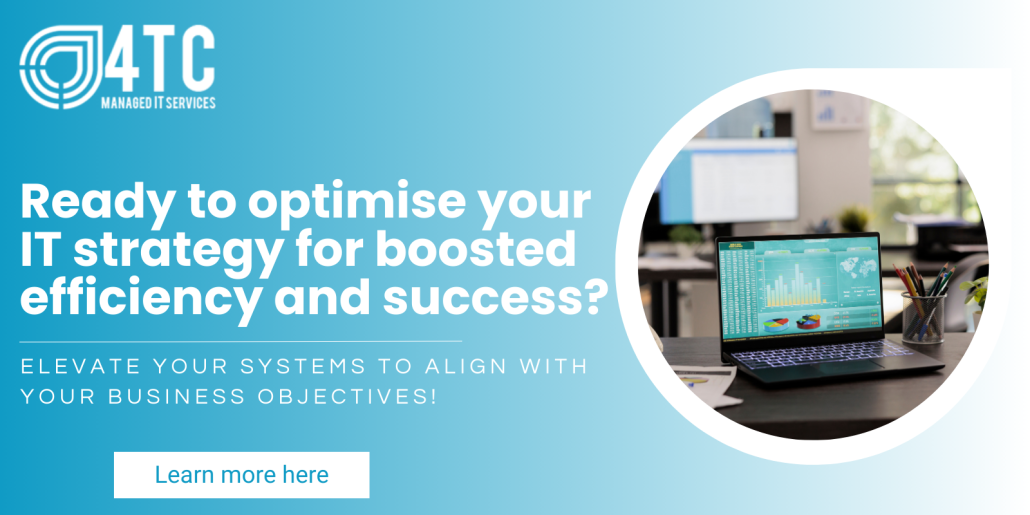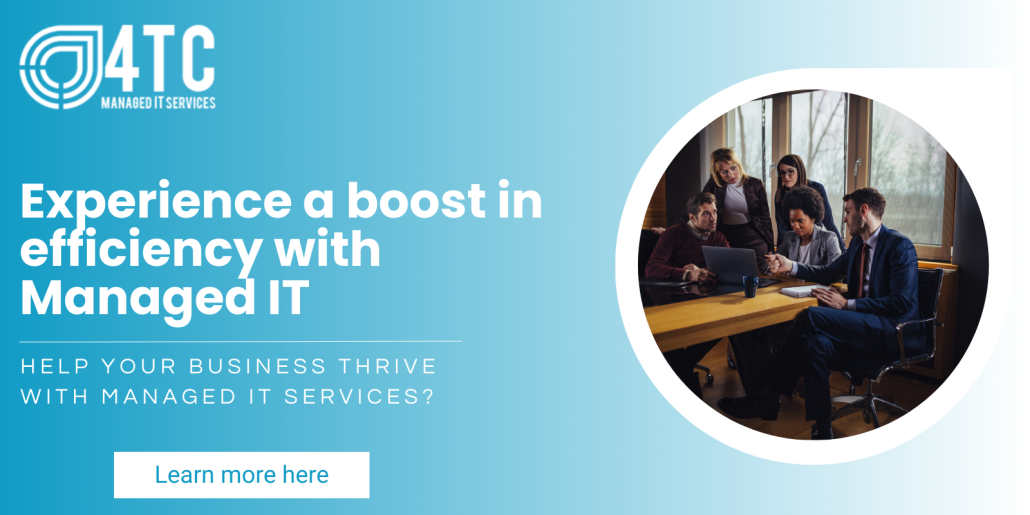Latest News for 4TC
We have loads to say!
We have loads to say!
Rachael Medhurst, Course Leader and Senior Lecturer in Cyber Security NCSA, University of South Wales
The festive season is a time for joy, family and festive cheer. However, it’s also a prime target for cybercriminals. As online shopping ramps up, so does the risk of falling prey to cyber-attacks. That’s why it’s crucial to be extra vigilant about your cybersecurity during this time.
Here are some essential tips to safeguard yourself and your data during the festive period:
Phishing is when criminals use scam emails, text messages or phone calls to trick their victims. Their goal is often to make you visit a certain website, which may download a virus on to your computer, or steal bank details or other personal data.
This type of scam tends to increase at this time due to the amount of people having bought or received new gadgets and technology.
Look out for there being no direct reference to your name in any communications, with wording such as “Dear Sir/Madam” or other terms such as “valued customer” being used instead. Grammar and spelling mistakes are also often present.
Be wary of any suspicious links or attachments within emails too, and don’t click them. It’s better to contact the company directly to check if the message is genuine. You can also report suspicious messages and phishing scams to the government’s National Cyber Security Centre.
The convenience of online shopping is undeniable, especially during the festive season. However, it’s crucial to prioritise your security when buying online.
Before entering your personal and financial information on any website, ensure it’s legitimate and secure. Look for the “https” in the address bar and a padlock icon, which indicates a secure and encrypted connection.
When creating passwords for online shopping accounts, use strong, unique combinations of letters, numbers and symbols. Avoid using the same password for multiple accounts, as a breach on one site could compromise all your others.
As with shopping in the real world, be cautious when encountering offers that are significantly below usual prices or which make extravagant promises. Always conduct thorough research on the seller and product before making a purchase. If a deal seems too good to be true, it probably is.
And if you are out shopping in towns or city centers, there will often be a large number of public Wi-Fi options available to you. However, criminals can intercept the data that is transferred across such open and unsecured Wi-Fi. So, avoid using public Wi-Fi where possible, especially when conducting any financial transactions.
While social media platforms provide people with a means to keep in touch with family and friends over the festive period, they are often a goldmine for scams and malware (software designed to disrupt, damage or gain unauthorised access to a computer). In the spirit of the festive season, people often share an abundance of personal information on social media, often without considering the potential consequences.
This trove of data can make people vulnerable to cyber-attacks. Scammers can exploit this information to gain unauthorised access to social media accounts, steal personal information, or even commit identity theft. To protect yourself, be mindful of what you share.
Be wary when interacting with posts and direct messages, especially if they contain suspicious links or attachments. Before clicking on anything, hover over the link to verify its destination. If it shows a website you don’t recognise or seems unrelated to the message, do not click on it. If you receive a message from someone you know but the content seems strange or out of character, contact them directly through a trusted channel to verify its authenticity.
Likewise, be wary of messages containing urgent requests for money or personal information from businesses. Genuine organisations will never solicit sensitive details through social media.
There are many buy and sell platforms available on social media. But while such platforms can be a great place to find a unique gift, it is also important to remember that not all sellers may be legitimate. So, it’s vital that you don’t share your bank details. If the seller sends a link to purchase the item, do not use it. When meeting to collect an item, it’s generally safer to use cash rather than transferring funds electronically.
As well as being a time for giving and receiving gifts, the festive season is also ripe for cybercriminals to exploit the excitement surrounding package deliveries.
Scammers often pose as legitimate delivery companies, sending emails or text messages claiming that a delivery attempt was unsuccessful or requiring additional fees for processing, or even customs clearance. Typically, these messages contain links or phone numbers that, when clicked or called, lead to fake websites or automated phone systems designed to collect personal information or payments.
To protect yourself, always verify the legitimacy of any delivery notifications you receive. Check the sender’s email address or phone number against the official contact information for the delivery company. If the information doesn’t match or seems suspicious, don’t click any links or provide personal details.
Legitimate delivery companies will never ask for upfront payment or sensitive information through unsolicited messages or calls.
Remember, cybercriminals are skilled at manipulating the festive spirit to their advantage. Stay vigilant, exercise caution, and don’t let your excitement for gifts and deliveries compromise your cybersecurity.
Source: https://nation.cymru/news/how-to-protect-yourself-from-cyber-scammers-over-the-festive-period/
Advances in artificial intelligence pose a growing threat to the integrity of the next general election in the UK, Britain’s cyber security agency has warned.
The National Cyber Security Centre (NCSC) said countries such as Russia would likely seek to meddle with the outcome of the poll – which must take place by January 2025 – as well as other major elections in western democracies in the coming year, including in the United States.=
In an annual review of a broad range of cyber security issues, the agency, which is part of GCHQ, warned about the prospect of increasingly realistic, deepfake videos and other forms of disinformation designed to influence voter preferences.
“While the UK’s use of paper voting in general elections makes it significantly harder to interfere with our elections, the next election will be the first to take place against the backdrop of significant advances in AI,” it said.
“But rather than presenting entirely new risks, it is AI’s ability to enable existing techniques which poses the biggest threat.”
This included fabricated online posts at speed and deepfake campaigns spread across social media at great speed.
“Any interference or attempts to undermine our political discourse are completely unacceptable and the UK government is committed to enhancing our capabilities and countering the threat from online harms, such as disinformation,” the NCSC said.
It described how the “threat landscape” had evolved “significantly” since the last UK general election in 2019, in particular in the wake of Russia’s war with Ukraine.

That conflict “has made the prospect of influencing the political discourse in democracies ever more attractive to state actors”, the agency said.
It also warned about the emergence of cyber actors that are aligned with malign states such as Russia and share the same ideological goals but can act with less restraint, calling this category “a new class of adversary for the UK to counter”.
“The NCSC assesses that democratic events, such as elections, almost certainly represent attractive targets for malicious actors and so organisations and individuals need to be prepared for threats, old and new,” the NCSC said.
In response, the UK has set up a Defending Democracy Taskforce and a Joint Election Security Preparedness unit.
As well as a focus on Russia, the NCSC report agency also flagged the ongoing cyber threat posed by China, Iran and North Korea.
Recent advances in large language models (LLMs) have made artificial intelligence more adaptable than ever before, but that comes with a drawback: lies. Generative AI tends to make things up, but Google DeepMind has devised a new LLM that sticks to mathematical truths. The company’s FunSearch can solve highly complex math problems. Miraculously, the solutions it generates aren’t just accurate; they’re entirely new solutions that no human has ever found.
FunSearch is thus named because it searches for mathematical functions, not because it’s fun. Although, some people might consider the cap set problem a real hoot—mathematicians can’t even agree on how best to solve it, making it a genuine numerical mystery. DeepMind previously made advances in AI with its Alpha models like AlphaFold (protein folding), AlphaStar (StarCraft), and AlphaGo (playing Go). These systems were not based on LLMs, but they did reveal new mathematical concepts.
With FunSearch, DeepMind started with a large language mode, a version of Google’s PaLM 2 called Codey. There’s a second LLM layer at work, which scans Codey’s output and prunes incorrect information. The team behind this work didn’t know if this approach would work, and they’re still not sure why it does, according to DeepMind researcher Alhussein Fawzi.
To start, DeepMind engineers created a Python representation of the cap set problem, but they left out the lines that described the solution. Codey’s job was to add lines that accurately solved the problem. The error-checking layer then scores the Codey solutions to see if they are accurate. In high-level math, equations may have more than one solution, but not all of them are considered equally good. Over time, the algorithm identifies the best solutions from Codey and feeds them back into the model.

DeepMind let FunSearch churn for several days long enough to generate millions of possible solutions. This allowed FunSearch to refine the code and produce better results. According to the newly published research, the AI came up with a previously unknown but correct solution to the cap set problem. DeepMind also turned FunSearch loose on another difficult bit of math called the bin packing problem, an algorithm that describes the most efficient way to pack bins. FunSearch found a faster solution than those calculated by humans.
Mathematicians are still struggling with integrating LLM technology into their work, and the work at DeepMind shows a possible path forward. The team believes this approach has potential because it generates computer code rather than the solution. This is often easier to understand and verify than raw mathematical outputs.
Source: https://www.extremetech.com/extreme/google-deepmind-solves-unsolvable-math-problem-with-ai
A supercomputer scheduled to go online in April 2024 will rival the estimated rate of operations in the human brain, according to researchers in Australia. The machine, called DeepSouth, is capable of performing 228 trillion operations per second.
It’s the world’s first supercomputer capable of simulating networks of neurons and synapses (key biological structures that make up our nervous system) at the scale of the human brain.
DeepSouth belongs to an approach known as neuromorphic computing, which aims to mimic the biological processes of the human brain. It will be run from the International Centre for Neuromorphic Systems at Western Sydney University.
Our brain is the most amazing computing machine we know. By distributing its computing power to billions of small units (neurons) that interact through trillions of connections (synapses), the brain can rival the most powerful supercomputers in the world, while requiring only the same power used by a fridge lamp bulb.
Supercomputers, meanwhile, generally take up lots of space and need large amounts of electrical power to run. The world’s most powerful supercomputer, the Hewlett Packard Enterprise Frontier, can perform just over one quintillion operations per second. It covers 680 square meters (7,300 sq ft) and requires 22.7 megawatts (MW) to run.
Our brains can perform the same number of operations per second with just 20 watts of power, while weighing just 1.3kg-1.4kg. Among other things, neuromorphic computing aims to unlock the secrets of this amazing efficiency.
On June 30 1945, the mathematician and physicist John von Neumann described the design of a new machine, the Electronic Discrete Variable Automatic Computer (Edvac). This effectively defined the modern electronic computer as we know it.
My smartphone, the laptop I am using to write this article and the most powerful supercomputer in the world all share the same fundamental structure introduced by von Neumann almost 80 years ago. These all have distinct processing and memory units, where data and instructions are stored in the memory and computed by a processor.

For decades, the number of transistors on a microchip doubled approximately every two years, an observation known as Moore’s Law. This allowed us to have smaller and cheaper computers.
However, transistor sizes are now approaching the atomic scale. At these tiny sizes, excessive heat generation is a problem, as is a phenomenon called quantum tunnelling, which interferes with the functioning of the transistors. This is slowing down and will eventually halt transistor miniaturisation.
To overcome this issue, scientists are exploring new approaches to computing, starting from the powerful computer we all have hidden in our heads, the human brain. Our brains do not work according to John von Neumann’s model of the computer. They don’t have separate computing and memory areas.
They instead work by connecting billions of nerve cells that communicate information in the form of electrical impulses. Information can be passed from one neuron to the next through a junction called a synapse. The organisation of neurons and synapses in the brain is flexible, scalable and efficient.
So in the brain – and unlike in a computer – memory and computation are governed by the same neurons and synapses. Since the late 1980s, scientists have been studying this model with the intention of importing it to computing.

Neuromorphic computers are based on intricate networks of simple, elementary processors (which act like the brain’s neurons and synapses). The main advantage of this is that these machines are inherently “parallel”.
This means that, as with neurons and synapses, virtually all the processors in a computer can potentially be operating simultaneously, communicating in tandem.
In addition, because the computations performed by individual neurons and synapses are very simple compared with traditional computers, the energy consumption is orders of magnitude smaller. Although neurons are sometimes thought of as processing units, and synapses as memory units, they contribute to both processing and storage. In other words, data is already located where the computation requires it.
This speeds up the brain’s computing in general because there is no separation between memory and processor, which in classical (von Neumann) machines causes a slowdown. But it also avoids the need to perform a specific task of accessing data from a main memory component, as happens in conventional computing systems and consumes a considerable amount of energy.
The principles we have just described are the main inspiration for DeepSouth. This is not the only neuromorphic system currently active. It is worth mentioning the Human Brain Project (HBP), funded under an EU initiative. The HBP was operational from 2013 to 2023, and led to BrainScaleS, a machine located in Heidelberg, in Germany, that emulates the way that neurons and synapses work.
BrainScaleS can simulate the way that neurons “spike”, the way that an electrical impulse travels along a neuron in our brains. This would make BrainScaleS an ideal candidate to investigate the mechanics of cognitive processes and, in future, mechanisms underlying serious neurological and neurodegenerative diseases.
Because they are engineered to mimic actual brains, neuromorphic computers could be the beginning of a turning point. Offering sustainable and affordable computing power and allowing researchers to evaluate models of neurological systems, they are an ideal platform for a range of applications. They have the potential to both advance our understanding of the brain and offer new approaches to artificial intelligence.
Most modern businesses rely heavily on their IT systems to manage internal processes, coordinate projects, and serve their customers. The integrity and performance of these systems is therefore vital to ensuring smooth business operations, meeting the expectations of customers, and managing relationships with all business stakeholders.
As we discussed previously, IT management and maintenance is vital to the delivery of efficient and reliable digital systems, however it isn’t the only piece in the jigsaw. You also need to ensure that your IT infrastructure is properly aligned with your business objectives, has the ability to scale and accommodate anticipated demand, and offers the digital experience that today’s tech-savvy customers both demand and expect.
4TC Managed IT Services – Proactive IT Services and Innovative Solutions for London Businesses
From managed IT and support, to cyber security and cloud services, 4TC provides the full spectrum of IT services London businesses need to grow and thrive in our digital age. Our mission is to help businesses work more productively and securely, with expertly managed solutions tailored to solve longstanding business challenges.
Partnering with a managed IT service provider grants businesses access to a wealth of technical expertise and industry insights. This allows MSPs to function as strategic partners to businesses, guiding and helping them adopt tailored solutions that meet their needs both now and into the future. In this article, we want to demonstrate how managed IT service providers can help businesses better align their IT with their strategic objectives, and optimise technology to achieve better performance and business efficiency.
At the beginning of an IT partnership, managed service providers work closely with businesses to understand their overarching objectives so that any strategic planning that follows helps drive the business towards its strategic goals.
This exercise will involve extensive consideration of both long and short term objectives, and may involve consultation with multiple stakeholders across the business in order to gain a range of perspectives. Organisational goals might include expansion plans, revenue targets and customer satisfaction outcomes.
The goal alignment assessment will take into account the interplay between business processes and the current IT system. It will consider any dependencies that exist within workflows, and any existing IT pain points that inhibit process efficiency. A technology capability analysis may be conducted, to determine the current IT system’s maturity, and its ability to support the business’s goals going forward.
This vital first step forms the basis for effective strategic planning, and ensures the IT provider has a full, contextualised understanding of the business, its goals and how well these are being supported by its current IT infrastructure.
Following on from the goal alignment assessment, managed service providers develop ‘technology roadmaps,’ which set out a phased plan for implementing the IT changes required to achieve the organisation’s goals using technology.
This phase of strategic planning maps technological solutions to specific goals, with great care taken to choose solutions that are appropriate to the scale, nature, compliance needs and budget of the business. Consideration could be given to a wide range of IT elements, including software, hardware, cloud services, cyber security controls and data management systems.
In most instances, a technology roadmap will seek to introduce changes incrementally, in order to minimise disruption, ensure project costs are manageable, and to align the IT strategy with the organisation’s timeline for achieving its goals more broadly.
After taking into account objectives, constraints and other requirements, technology roadmaps developed by MSPs help businesses leverage their IT system to achieve strategic objectives, ensure IT performance is continuously optimised, and move forward with a futureproof technology stack.
A key aspect of the strategic IT guidance offered by managed service providers involves ensuring IT assets and resources are being deployed optimally in support of organisational objectives: a practice known as ‘resource optimisation.’
Resource optimisation will often feature an IT audit, a process that seeks to understand the lie of the land in terms of the business’s IT. This audit will aim to expose inefficiencies and redundancies, such as duplicate/overlapping software, underutilised hardware, and manual processes that could be quickly and easily automated.
Through resource optimisation, managed service provider can help businesses eliminate wasteful IT expenditure, introduce time-saving initiatives like automation to improve productivity, and create strategies for IT streamlining to create simpler, more efficient workflows.
Ensuring IT systems are able to adapt and scale to meet changing business requirements is a vital consideration in strategic IT planning. Managed service providers can help businesses assess the scalability of their current IT infrastructure, and plan for changes that provide greater capacity when certain growth benchmarks are exceeded.
This aspect of strategic planning is also intimately linked with IT performance. MSPs will assess whether current IT systems have the capacity to handle increases in workload, data volumes and user demands without significant performance degradation. If current performance limitations are found, dynamic resource allocation may be implemented as a short-term option, whilst technology architecture that permits seamless scalability is explored for the future.
If the business is anticipating rapid, dynamic growth in the near future, an MSP can prescribe a range of highly scalable, future-ready IT solutions that can be quickly adapted to fast changing requirements. These include the likes of cloud solutions, virtualisation and modular hardware. A managed service provider can also help the organisation develop a diverse technology stack, designed to aid resilience and flexibility by avoiding the pitfalls of being locked into a single technology platform. This might involve exploring hybrid cloud, or multi-cloud setups as an alternative to fully on-premises hosting or consolidation into a single cloud service.
Today, businesses are required to navigate a complex web of data protection regulations and standards, including the GDPR and PCI DSS. Managed service providers can help organisations weave compliance into the fabric of their IT infrastructures, ensuring cyber security measures meet the requirements set by regulators, and that data controls offer an appropriate level of information oversight and governance.
Security and compliance integration will typically begin with a cyber security audit. This exercise will map out existing security controls, seek to identify existing vulnerabilities, and determine how well the current security arrangements meet the organisation’s security needs in the context of its industry and regulatory requirements.
Once the assessment process is complete, a data security and compliance framework can be developed, containing both technical controls and procedural measures for ingraining compliance, and a strong security posture, into the fabric of the IT system. This framework might include data access controls, encryption, firewalls, information security policies and any other measures deemed necessary and proportionate.
By making data security and compliance an integral part of strategic IT planning, managed service providers can help organisations manage risk, keep sensitive data secure, and support reliable and efficient business operations.
Optimising the performance of your IT system is one thing, but it’s an altogether greater challenge to ensure your technology remains fast, efficient and aligned with your goals as your business grows and evolves. By partnering with a managed IT services provider, you benefit from IT strategy planning that ensures your technology is able to scale with your needs, adapt to changing pressures, and remains continuously aligned with your business processes and compliance requirements.
4TC Managed IT Services – Uniting People, Processes and Technology
Secure, stable and optimised IT infrastructure is critical to the success of all businesses in our information age. 4TC helps businesses across London and the Southeast realise their potential through the delivery of expertly managed IT services and support, and solutions that solve business challenges by achieving perfect alignment between people, processes and technology. Get assistance with your IT challenges today by getting in touch, we’ll be glad to assist you!

If you’re thinking about outsourcing your IT needs to a managed service provider, you’re likely drawn by the prospect of performance-optimised IT. In today’s dynamic and digitised business environment, you can’t afford for your vital systems to break down, and you need your technology to perform flawlessly so that your business operates efficiently and productively. So how can a managed service provider ensure that your IT never misses a beat and truly delivers for your business?
4TC Managed IT Services – Proactive IT Services and Innovative Solutions for London Businesses
Here at 4TC, our managed IT services, responsive support, and tailored solutions are designed to help London businesses achieve peak efficiency and grow sustainably. We employ a proactive approach across every aspect of our service offering, ensuring our clients enjoy fast, secure and robust IT infrastructure that facilitates maximum operating efficiency. We do this by deploying a number of technologies and IT management best practices, which combine to deliver the IT performance that our dynamic clients have come to expect.
In this article, we’ll provide a brief guide to how an IT managed service provider can help you achieve better business efficiency through IT performance optimisation. We’ll explore the techniques, technologies and practices that form vital ingredients to the delivery of fast, reliable and secure business IT.
Using Remote Monitoring and Management (RMM) software, plus a host of other remote-capable IT management solutions, an IT managed service provider can carry out a range of performance optimisation strategies. These strategies are designed to complement one another, to support a fast, responsive, high-quality end user experience. Here are some of the elements performance optimisation strategies often entail:
Resource Allocation
A managed service provider can monitor and disperse workloads across multiple servers and components. This ensures network traffic flows freely, avoiding the performance pitfalls that can arise when a network component becomes overloaded. CPU usage, memory usage and disk input/output are just some of the metrics that are closely observed.
Load Balancing
Load balancing involves distributing network traffic volumes across available servers, avoiding performance bottlenecks, and ensuring resources are assigned efficiently. A managed service provider can perform this vital performance optimisation strategy by continuously monitoring server health, and regulating and directing network traffic accordingly. If one server is under strain, or suffering issues, inbound requests can be assigned to healthier servers that have the resource capacity to cope.
Network Optimisation
A managed service provider can take a number of actions to ensure seamless and fast cross-network data flow, that maximises the use of available resources. By optimising network configurations, implementing Quality of Service (QoS) policies and, where necessary, prioritising critical data traffic, an MSP can ensure that network bandwidth is managed efficiently, and in a way that supports business critical functions.
Latency Reduction
‘Latency’ refers to the time delay, or ‘lag’ that occurs as data transits a computer network. Some latency is inevitable, but too much can have a detrimental impact on the experience for end users. A managed service provider can play a critical role in resolving network latency issues, by identifying and resolving the issues at play, which might include inefficient routing and network congestion.
Caching Mechanisms
A managed service provider can improve network responsiveness by deploying caching mechanisms, which make frequently used information readily available to applications and services. These avoid the need to fetch information from source in each instance and help contribute to a responsive and seamless user experience.
Performance Monitoring and Analytics
Performance monitoring tools can be deployed to measure, capture and analyse system performance across a variety of metrics, including response times, resource utilisation, error rates and more. This analysed data can be used to identify trends, forecast future problems and support informed performance optimisation decision-making. Data can also be leveraged for capacity planning purposes, ensuring that necessary provisions can be made ahead of periods of increased demand or anticipated growth.
A proactive managed service provider will carry out a comprehensive programme of maintenance designed to foresee and address network issues, and resolve vulnerabilities before they evolve into costly episodes of IT downtime. The following elements usually form the basis of an IT provider’s scheduled maintenance activities:
Patch Management
Security updates, commonly referred to as ‘patches,’ are software updates that vendors or manufacturers release to enhance the security of their products or address discovered vulnerabilities. A managed service provider will usually take the lead in testing, applying and configuring these patches, to ensure software vulnerabilities are resolved in a timely manner that leaves very little time for malicious actors to exploit them. Proactive patch management is a vital component in maintaining a robust cyber security posture, and in sustaining the performance integrity of business-critical software and systems.
Task Automation
The remote management and monitoring software used by managed service providers often enables the automation of routine maintenance tasks such as disk clean-ups and defragmentation. This automation ensures that tasks beneficial to system performance are carried our regularly and consistently, helping to ensure a smooth and responsive user experience.
Hardware Health Checks
By performing regular diagnostic inspections of critical hardware components, including servers, storage devices and networking infrastructure, a managed service provider can help foresee hardware failures, and take the appropriate steps to avert system impact.
Performance Tuning and Continuous Improvement
A managed service provider can make use of the wealth of network activity data at their disposal to introduce a raft of system refinements designed to enhance overall performance. Such refinements might include altering configurations, tweaking setting and even optimizing programme code.
This activity data is continually gathered, allowing system administrators to introduce iterative enhancements on an ongoing basis, ensuring that system resources are consistently aligned with organisational needs, and the changing demands placed on them.
So far, we’ve talked about the proactive elements that constitute an effective IT support and management service, however, it’s important to recognise the vital supporting role played by post-incident support functions. When an IT problem strikes, you need issue resolution that prioritises a root cause fix, and restores critical functionality in the quickest possible time. Here’s how a managed service provider can help minimise downtime and enhance efficiency through responsive support services:
24/7 Helpdesk Support
The best-managed service providers offer 24/7 helpdesk support, backed by competitive response time guarantees. Utilizing ticketing systems, support requests are efficiently managed and tracked from initial submission to resolution. Tiered support structures assign priority ratings to issues, ensuring that critical and highly complex issues receive expedited support. These issues are handled by appropriately qualified engineers to guarantee a swift and lasting fix.
Remote Troubleshooting
IT support personnel make use of remote access tools which enable them to connect to and remotely configure user devices without the need to be physically present. These tools allow the vast majority of IT issues to be resolved remotely, expediting issue resolution dramatically, and minimising downtime and any subsequent lost productivity. Screen sharing allows IT support to view the user’s desktop environment in order to gain a first-hand understanding of the issue present, and diagnostic capabilities allow them to review a wide range of system information, including activity logs, configurations and performance data. These capabilities combine to give IT support teams formidable remote troubleshooting capabilities.
By taking a data-driven, proactive approach to network optimisation, undertaking a programme of preventative maintenance, and provide fast, expert support for any issues that slip through the net, a managed IT service provider can offer everything your business needs to operate performance-optimised and dependable IT infrastructure. Give your team the slick, fast technology they need to work effectively, and eliminate the IT outages that are holding your business back by exploring the benefits of managed IT services today.
4TC Managed IT Services – Uniting People, Processes and Technology
Secure, stable and optimised IT infrastructure is critical to the success of all businesses in our information age. 4TC helps businesses across London and the Southeast realise their potential through the delivery of expertly managed IT services and support, and solutions that solve business challenges by achieving perfect alignment between people, processes and technology. Get assistance with your IT challenges today by getting in touch, we’ll be glad to assist you!


Email: support@4tc.co.uk
Tel: 020 7250 3840
5th Floor, 167‑169 Great Portland Street
London
W1W 5PF
Dew Gates The Street
High Roding
Essex
CM6 1NT

